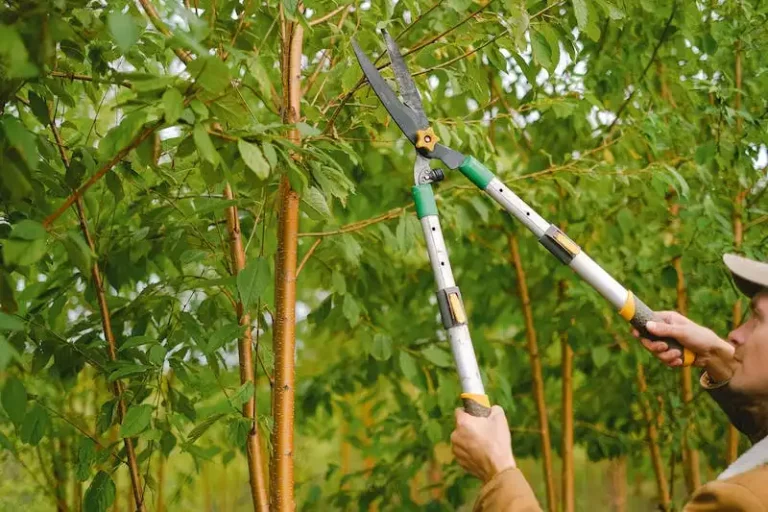Propagating fruit trees from cuttings can be a simple and rewarding means of growing your own fruit trees. Whether you are a beginner or an experienced horticulturist, this method allows you to create new trees that are genetically identical to their parent tree. This can be especially useful if you have a particular fruit tree that you wish to reproduce. In this article, we will discuss the different techniques for propagating fruit trees from cuttings.
One popular method of propagating fruit trees from cuttings is through the use of a greenhouse. The greenhouse provides the ideal environment for rooting the cuttings as it allows for controlled temperature, humidity, and light levels. To get started, you’ll need to prepare a rooting medium, such as sand or sphagnum moss, and a misting system to ensure the proper humidity levels for the cuttings. Once the cuttings have rooted, they can be transplanted to larger pots or directly into the ground.
Another method of propagating fruit trees from cuttings is by using a simple layering technique. This involves bending a low-hanging branch or runner of the parent tree to the ground and burying a section of it in the soil. Over time, roots will develop from the buried section, and once they are well established, the new tree can be separated from the parent tree and transplanted. This method is particularly effective for plants like brambles, where layering can result in a bunch of new plants.
For some fruit trees, particularly those that do not produce roots easily from cuttings or layering, the use of hormone powder can stimulate root growth. Hormone powders can be purchased from garden centers and are typically applied to the cut end of the cutting before it is planted. This helps to ensure that the cutting will take root and grow into a new tree. However, it is worth noting that not all fruit trees respond well to hormone treatment, so it is important to research the specific requirements of the tree you wish to propagate.
Apple Tree Rooting: Learn About Planting Apple Tree Cuttings
Rooting apple tree cuttings is a possible and popular method of propagating apple trees. This technique allows you to reproduce your favorite apple tree variety without the need for seeds or grafting. It is commonly used by home gardeners who want to produce multiple apple trees from a single parent tree. Rooting apple tree cuttings involves taking a section of a young, healthy tree and encouraging it to grow its own roots.
There are several methods that can be used for rooting apple tree cuttings. One common technique is called “whip and tongue grafting,” which involves grafting a small section of a rootstock onto the end of a limb. Another method is the “cleft graft,” where a V-shaped cut is made in the rootstock and a scion is inserted into the cut. Both of these methods require some expertise and careful handling to be successful.
A simpler and easier method for rooting apple tree cuttings is the use of semi-hardwood cuttings. These cuttings are taken from the current season’s growth, usually in late spring or early summer. The cuttings should be about five to six inches long, with their leaves removed from the lower half-inch of the stem.
To root the apple tree cuttings, you will need a sterile rooting medium. A mixture of sphagnum moss and sand is commonly used. Make a small hole in the rooting medium and insert the bottom end of the cutting into it. Firmly tamp the mixture around the cutting to hold it in place.
Once the cuttings are planted, it is important to keep them in a high humidity environment to prevent them from drying out. You can create a mini greenhouse by covering the cuttings with a plastic bottle or placing them in a plastic bag. This will help to maintain the necessary moisture levels and increase the chances of successful rooting.
Apple trees are deciduous, meaning they lose their leaves in the winter. During this dormant period, you can also propagate apple trees through a method called “stooling.” Stooling involves removing a ring of bark from the rootstock and covering it with moist soil or sphagnum moss. This encourages the roots to grow along the cut area, resulting in new shoots that can be separated and grown as new apple trees.
If you are unsure about how to root apple tree cuttings, it is always a good idea to seek advice from your local university extension or a reputable nursery. They can provide guidance and specific recommendations based on your unique growing conditions.
Rooting apple tree cuttings is a rewarding way to propagate your favorite apple tree varieties. With the right techniques and care, you can successfully grow new apple trees from cuttings and enjoy a bountiful harvest of your favorite fruit.
Can You Root Apple Tree Cuttings
Apple tree cuttings can be rooted to propagate new apple trees. The process of rooting apple tree cuttings involves taking a piece of stem or branch from an existing apple tree and encouraging it to form roots. This technique is commonly used in horticulture to propagate fruit trees, including apple trees.
The best time to root apple tree cuttings is usually in late winter or early spring, around March, when the tree is dormant. It’s important to collect the cuttings from healthy and vigorous apple trees, without any signs of disease or damage. The cuttings should be about 1/4 to 1/2 inch thick and usually around 6-10 inches long, with several buds along the stem.
To root apple tree cuttings, you can use different techniques, including air layering, whip and tongue grafting, or using root-inducing hormones. One common method is called the “wrap and pot” technique. In this process, the cuttings are wrapped with moist sphagnum moss and then placed in a pot filled with a rooting medium, such as sand or a mix of sand and peat moss. The cuttings should be thoroughly watered, and the pot should be covered with a plastic bag or placed in a greenhouse to maintain high humidity.
Rooting hormones can also be used to encourage root growth. A solution of salicylic acid, typically 1 teaspoon per gallon of water, can be applied to the base of the cuttings before placing them in the rooting medium. This can help promote the formation of new roots.
During the rooting process, it’s important to maintain a high humidity level and a moderate temperature, including keeping the cuttings at around 70-80 degrees Fahrenheit. Misting the cuttings with water several times a day can help prevent them from drying out. However, it’s crucial to avoid over-misting, as it can lead to rot or fungal diseases.
Rooting apple tree cuttings may take several weeks or even months to form roots. It’s important to check the cuttings regularly for signs of new growth, such as the emergence of new leaves or the appearance of root buds. Once the cuttings have rooted, they can be potted or planted in the ground to continue their growth.
In summary, yes, you can root apple tree cuttings and propagate new apple trees. By using proper techniques, including collecting healthy cuttings, providing appropriate humidity and temperature conditions, and using rooting hormones if desired, you can successfully root apple tree cuttings and grow new trees.
Starting Apple Tree Cuttings
One method of propagating apple trees is by starting cuttings. This is a sexual method of reproduction that involves taking a piece of the tree and allowing it to develop roots and grow into a new tree.
To start apple tree cuttings, you’ll need a shady and cool location. The loss of moisture through the leaves of the cutting is high, so a cool and shady environment helps to reduce this loss.
The cuttings should be taken from the previous season’s growth and should be approximately 12 inches long. Make sure to collect cuttings from disease-resistant cultivars or from healthy, vigorous trees.
| Step | Description |
|---|---|
| 1 | Take hardwood cuttings during the late winter or early spring when the tree is dormant. |
| 2 | Make a clean, narrow cut at the upper end of each cutting, about 1/4 inch above a bud. |
| 3 | Prepare a rooting medium by mixing equal parts peat moss, perlite, and coarse sand in a slat or plastic pot. |
| 4 | Insert the cuttings into the medium, leaving only the top bud exposed. The cuttings should be placed 2-3 inches apart. |
| 5 | Water the cuttings thoroughly and then allow the excess moisture to drain. |
| 6 | Cover the pot with a plastic bag or place it in a humidity dome to maintain high humidity. |
| 7 | Place the pot in a warm and bright location, but out of direct sunlight. |
| 8 | Mist the cuttings regularly to keep them moist and help establish roots. |
| 9 | After about 4-6 weeks, check for root development by gently tugging on the cuttings. If they show resistance, it means roots have formed. |
| 10 | Once the cuttings have rooted, they can be transplanted into individual pots or directly into the ground. |
Starting apple tree cuttings is a great way to propagate new trees without the use of hormones or the need for grafting. This method can be used for other deciduous fruit trees as well, such as nectarines. By using the appropriate techniques and providing the right conditions, you can successfully grow new apple trees from cuttings.



